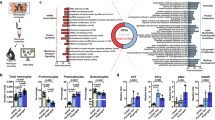Summary
Microscopic observations of the normal “phagocytic tissues” (in the sense of the classic authors) of the dorsal diaphragm in the two Orthopterans Gryllus bimaculatus and Locusta migratoria unequivocally demonstrate the hematopoietic nature of these cellular accumulations. In the two species, the hematopoietic elements develop from a large number of so-called reticular cells of mesodermic origin, which resemble closely the reticular cells of the hematopoietic organs of Vertebrates. As it is the case in Vertebrates, the differentiation of the hematopoietic elements into mature blood cells occurs in the two Orthopterans also in isogenic cell islets. The phagocytic activity of the reticular cells explains the fact that these organs were classically considered in the Orthopterans as simple phagocytic organs.
The hematopoietic differentiation of the reticular cells can occur either in a poorly organized, loose tissue located along the dorsal vessel, as is the case in Locusta, or in a group of highly organized hematopoietic organs, as in Gryllus, which resemble far more the classical hematopoietic structures of Vertebrates. We give a detailed description of both types of organization, especially of the subdivision in Gryllus, of the hematopoietic organs into a cortex, where the haemocytes differentiate, and a medulla, where they can accumulate.
After severe hemorrhages, the hematopoietic organs of Gryllus show all the features of a dramatic stimulation of hematopoiesis; their function can thus be experimentally demonstrated.
Zusammenfassung
Mikroskopische Beobachtungen an normalen „phagozytären Geweben“ (im Sinne der älteren Autoren) entlang des dorsalen Diaphragmas der beiden Orthopteren-Arten Gryllus bimaculatus und Locusta migratoria zeigen übereinstimmend, daß diese Bildungen eine hematopoietische Struktur haben. Bei beiden Arten entwickeln sich die blutbildenden Stammzellen aus einer großen Anzahl sog. Retikularzellen mesodermalen Ursprungs, die den Retikularzellen der blutbildenden Gewebe der Vertebrata sehr stark ähneln. Wie bei den Vertebrata differenzieren sich bei den Insekten die Blutzellen in sog. isogenen Zellgruppen von gleichem Typus und gleichem Entwicklungsstadium. Die starke phagozytäre Neigung der Retikularzellen erklärt, warum die blutbildenden Gewebe der Orthoptera von den älteren Autoren als phagozytäre Organe angesprochen wurden.
Die hämatopoietische Differenzierung der Retikularzellen in reife Blutzellen (Haemozyten) findet entweder in einem lockeren Gewebe entlang des dorsalen Blutgefäßes, wie bei Locusta, statt, oder im inneren mehrerer, an das Herz gebundener, hoch organisierter blutbildender Organe, wie bei Gryllus, die noch stärker an die klassischen Strukturen der Vertebrata erinnern. Wir beschreiben im einzelnen beide Strukturtypen, insbesondere bei Gryllus die Einteilung der Organe in einen Cortex, in dem sich die Blutzellen bilden, und eine Medulla, in welcher sich die reifen Haemozyten ansammeln können.
Nach starken Blutverlusten zeigen besonders die blutbildenden Gewebe von Gryllus eine dramatische Stimulierung der Hämatopoiese an; die Punktion der hämatopoietischen Organe kann also ebenfalls experimentell nachgewiesen werden.
Similar content being viewed by others
Bibliographie
Arvy, L.: Données histologiques sur la leucopoïèse chez quelques Lépidoptères. Bull. Soc. Zool. France 78, 45–59 (1953a).
—: Contribution à l'étude de la leucopoïèse chez quelques Diptères. Bull. Soc. Zool. France, 78, 158–169 (1953b).
Cuenot, L.: Etudes physiologiques sur les Orthoptères. Arch. Biol. 14, 293–341 (1896).
Gulliver, G.: The works of William Hewson, F. R. S. Londres, Sydenham Soc. 1845.
Hoffmann, J. A.: Etude de la récupération hémocytaire après hémorragies expérimentales chez l'Orthoptère Locusta migratoria. J. Insect Physiol. 15, 1375–1384 (1969).
Hoffmann, J. A., Porte, A., Joly, P.: Présence d'un tissu hématopoïétique au niveau du diaphragme dorsal de Locusta migratoria (Orthoptère). C. R. Acad. Sci. (Paris) 266, 1882–1883 (1968).
—: Sur la nature hématopoïétique de l'≪organe phagocytaire≫ (Cuénot) chez Gryllus bimaculatus (Orthoptère Ensifère). C. R. Acad. Sci. (Paris) 267, 776–777 (1968).
Jones, J. C.: Current concepts concerning insect hemocytes. Amer. Zool. 2, 209–246 (1962).
- Hemocytopoiesis in Insects (sous presse) 1970.
Kowalevsky, A.: Ein Beitrag zur Kenntnis der Exkretionsorgane. Biol.Zbl. 9, 33–47, 65–76, 127–128 (1889).
L'Helias, C.: L'organe leucopoïétique des Tenthrèdes. Bull. Soc. Zool. France 78, 76–83 (1953).
Author information
Authors and Affiliations
Additional information
Il m'est un agréable devoir de remercier Mme. Clothilde Heyer et Mlle. Georgette Haller pour leur collaboration dévouée et compétente.
Rights and permissions
About this article
Cite this article
Hoffmann, J.A. Les organes hématopoïétiques de deux insectes orthoptères: Locusta migratoria et Gryllus bimaculatus . Z. Zellforsch. 106, 451–472 (1970). https://doi.org/10.1007/BF00335786
Received:
Issue Date:
DOI: https://doi.org/10.1007/BF00335786




